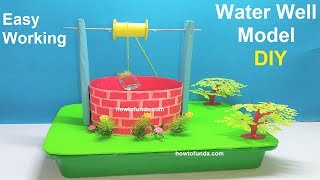A water well working model demonstrates how groundwater is accessed for human use through a well. It shows the process of digging, storing, and retrieving water, making it an ideal science exhibition project to explain the importance of groundwater resources.

Components of the Model
- Base: A sturdy base made from cardboard or wood to hold the structure.
- Well Structure: A cylindrical container or tube representing the well.
- Water Source: A hidden reservoir (e.g., a bowl or a small water tank) at the base to mimic groundwater.
- Pulley System: A small pulley attached above the well with a rope and bucket to draw water.
- Bucket: A small cup or container to fetch water.
- Surrounding Area: Decorative elements like trees, soil, and houses to show the environment around the well.
How It Works
- Groundwater Representation: The hidden reservoir at the bottom of the well represents groundwater, which accumulates through natural processes like rain infiltration.
- Water Retrieval:
- The bucket is attached to a rope and lowered into the well using the pulley system.
- When the bucket reaches the water, it is filled and pulled back up using the rope.
- Demonstration: By turning the pulley, water is drawn from the well and shown as a usable resource.
Conclusion
This working model effectively demonstrates how wells are used to access groundwater, an essential resource for drinking, irrigation, and daily needs. It highlights the importance of conserving groundwater and maintaining its quality for sustainable use. This simple yet educational project helps students understand the significance of wells in rural and urban areas.

